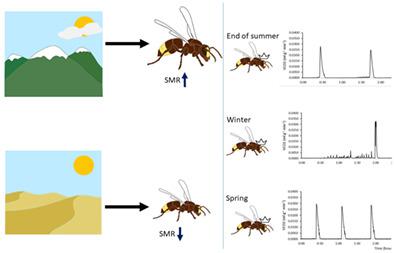INTRODUCTION
Species with a wide geographic range are exposed to diverse climatic conditions that drive and shape their phenotypic and genetic variation (Jackson et al., 2020). Both temperature and precipitation are ubiquitous selective forces, influencing molecular and physiological functions of organisms along their distribution (Bozinovic et al., 2011; Siepielski et al., 2017). Such organisms have evolved behavioural and physiological adaptations, including diapause, to face alternating periods of favourable and unfavourable environmental conditions at various temporal scales (Denlinger, 2008). In temperate climates, seasonality plays a significant role in the life history of animals, affecting the abundance of resources and thermal physiology (Kivelä et al., 2013; Varpe, 2017). When the temperature is harsh or food becomes scarce, some insects migrate to a better climate or wintering sites (Chapman et al., 2012; Satterfield et al., 2020), while others reduce their activity and metabolism (Beekman et al., 1998; Hodek, 2012; Tougeron, 2019). In higher elevations and latitudes, winter is more prolonged, and so is the winter hibernation or diapause of organisms in such climates (Hodkinson, 2005; Zervanos et al., 2010).
The Oriental hornet (Vespa orientalis) is a true, medium-size hornet (~250 mg), forming annual colonies in the spring, usually in underground cavities, that develop rapidly during the summer, and will have produced up to 2000 individuals by the beginning of autumn, when reproductives emerge (Ishay, 1976; Ishay & Ikan, 1968). Like other annual eusocial insects (Vespids and some Apoids), the young mated gynes (primary reproductive females destined to become a queen) of the Oriental hornet will enter diapause during the winter, carrying the genes for the colony that will be established in the following spring (Ishay et al., 1984; Perez & Aron, 2020).
The Oriental hornet has a wide distribution, including North Africa, Southern Asia, Southern Europe, and the Levant, and is the only member of the genus Vespa adapted to arid and hot habitats (Carpenter et al., 2013). The Oriental hornet is common throughout the country in Israel, including the extreme desert and the Mediterranean regions up to an altitude of 1300 m above sea level (the two major biomes in Israel). It is considered a significant agricultural pest, attacking the hives of honey bees (Apis mellifera) and damaging summer fleshy fruits, like grapes, dates, figs, and pomegranates (Dvořák, 2006; Glaiim, 2009; Taha, 2014). Recently, due to climate changes and human introduction, this species is continuously expanding into Europe, Central Asia and the Americas (Bressi et al., 2019; Sánchez et al., 2019; Temreshev, 2018; Werenkraut et al., 2021; Zachi & Ruicănescu, 2021).
We previously found that, unlike reported by Ishay (Ishay et al., 1967), Oriental hornets do not maintain their nest temperature at a constant 28°C, regardless of the ambient temperature. In the desert regions of Israel, the temperature in the nest was maintained at 34.2 ± 0.6°C, while in the high latitude Mediterranean regions, it is 27.6 ± 0.3°C (Volov et al., 2021). Although climate affects the thermal environment of the colony, the Oriental hornet can maintain its nest temperature within a relatively narrow range. We previously found no biochemical adaptations in the membranes of these hornets in different climates, as the lipid composition in the Oriental hornet remained highly conserved even under extreme climates and diet manipulations; still, significant differences in polar (assumed to be membrane originated) and non-polar lipid saturation levels were found between the different hornet castes (Volov et al., 2021).
Here, we studied the I. effect of climate on body size in Oriental hornets II. and the effect of climate on standard metabolic rate (SMR) of Oriental hornet workers and gynes from two extreme climates along their natural distribution and, III the diapause physiology of gynes during winter, a critical period in their life cycle. Body size has a vital role in animals' survival and the life course (Blackburn et al., 1999). A larger body can improve survival when food is limited (Heinze et al., 2003; Vesterlund et al., 2014). Both temperature and nutrition quality during the insect's development affects its final body size (Davidowitz et al., 2003, 2004). In relatively high temperatures, the development rate of an insect is accelerated, resulting in reduced body size of the adult. The opposite trend is observed in colder temperatures when the development is slower, and the adult body size is usually bigger (Partridge et al., 1994). For this reason, the temperature at which the larvae develop has a significant role in adult fitness (Scharf et al., 2013). We hypothesize that hornets from desert regions will have a smaller body size. We also hypothesize that desert hornets will have a lower metabolic rate, as the metabolic cold adaptation theory (MCA) suggests that animals inhabiting higher elevations, or higher latitudes with lower temperatures, will often have a higher metabolic rate. These higher metabolic rates compensate for the suppressive effect of low temperature on the insect's biochemical processes (Abram et al., 2017; Tattersall et al., 2012) and developmental rate (Addo-Bediako et al., 2002; Chown & Gaston, 1999).
In addition to the above hypothesis, we studied the diapause physiology of the Oriental hornet gynes and compared the SMR between gynes from two climatic regions. Diapause is a dynamic state of low metabolic activity, characterised by behavioural inactivity, morphogenesis, reproductive functions arrest, and slowing of growth (Danks, 1987, 2013). Preparation to diapause includes some critical physiological adjustments; pre-diapause insects often show an extended developmental period and undergo physiological changes such as additional accumulation of lipid reserves, cuticular hydrocarbons modifications, and nutrient storage proteins (Denlinger, 2002; Hahn & Denlinger, 2007). We hypothesize that gynes will have a lower metabolic rate in the colder climate region, especially at low temperatures, to survive the longer and colder winter in this region and will reduce their metabolic rate (metabolic depression) during winter compared to the pre and post diapause periods to conserve energy during the winter diapause. Here, we also compare respiratory patterns and metabolic rates between these three life stages of the gynes.



































 京公网安备 11010802027423号
京公网安备 11010802027423号